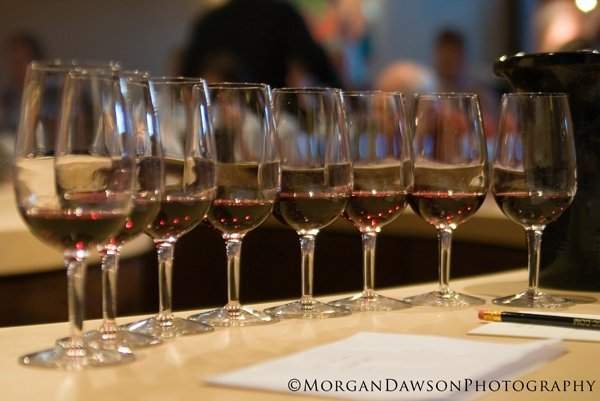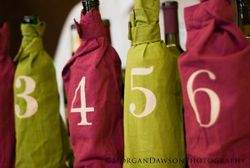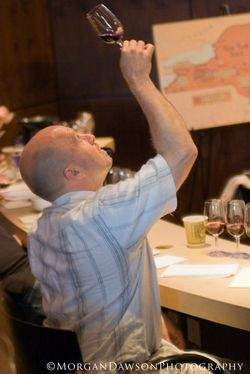
By Evan Dawson, Finger Lakes Editor
Photos by Morgan Dawson
When the demonstration room at the New York Wine & Culinary Center filled up at 10 a.m. on Tuesday morning, 328 glasses of cabernet franc lit up the amphitheater like strands of single-color Christmas lights. It was a bit daunting for the 42 winemakers, winegrowers, industry professionals, newspaper writers, retailers and bloggers.
And that was just the first flight.
When the event (
get some back story) finally ended three hours later we had tasted through 13 Finger Lakes 2007 cabernet francs, 3 Loire Valley cabernet francs, one Long Island cabernet franc, and 5 Finger Lakes 2007 reserve cabernet francs. Wine writer Holly Howell even brought her own gift for the group, a 2002 Loire that was just beautiful.
On this blog and in other forms of media we'll be hearing from retailers — who have to sell the wine — and writers who will share their own ideas. And I'm sure we'll hear from industry professionals. Here are some of my takeaways from an undeniably successful event:
Finger Lakes cabernet franc has a recognizable style.
It was pretty remarkable to see that the participants had no trouble discerning which wines were from the Finger Lakes and which were not. Cabernet franc has a local identity, which is important.
It's not always good, though. Some of the wines gave off odd, citrusy flavors (others referred to this as a persistent sour cherry note), and some of the wines still lacked depth and weight — even from a ripe vintage like 2007. But the best of the group were balanced with bright cherry, black pepper, and grilled herbs, and the very best added layers of mouthfeel that extended the finish of the wine.
The top-scoring wine was the Ravines Wine Cellars 2007 Cabernet Franc, and its appeal was best summarized by Fox Run assistant winemaker Tricia Renshaw. She remarked, before seeing the bottle revealed, "This is a delicious wine with great mouthfeel."
Can it be coincidental that the top-scoring wines were among the lowest-cropped wines? Yes, under-cropping can be an issue, but as one winemaker pointed out during the event, "The lower the yield, the more weight cabernet franc seems to have. You can't get that mouthfeel with over-cropped vines."
One winemaker confessed to me, in confidence, that recently they weren't careful and ended up with 7 tons per acre of cabernet franc. "Not only was the wine not very good, but there was a huge amount of it!" he said.
 Local winemakers do not seem to enjoy wines from other regions.
Local winemakers do not seem to enjoy wines from other regions.
This statement is a little broad-sweeping and probably a touch unfair, and maybe it will get some backlash, but I can't help it.
The bottom two wines based on score were the 2005 Charles Joguet Chinon (Dioterie cuvee, $36) and the 2005 Domaine des Vallettes Bourgueil ($12). The other non-FL wine, the Shinn Estate Vineyards 2007(Long Island), finished in the bottom half of the scoring pack.
Ah, but break down the numbers: Retailers and writers rated the Chinon and Shinn in the top 6 wines, while wine industry professionals had them way down the list.
Having now tasted the Shinn, I can say that I find all the hype for this wine to be absolutely justified. That's why I couldn't figure out why the majority of local wine professionals didn't care for it, and I wonder if there's a bit of "house palate syndrome" going on.
Granted, this is a small sample size to choose from. The Chinon bore some Brett character, and some in the audience said it was over-the-top. I simply hope that local professionals don't equate foreign wines with lesser quality — simply because they're different.
(I also make this assertion based on my exposure to many industry professionals who have rarely tasted wines from other regions. Many of the best local winemakers seek out wines from around the world, but I also see some who don't seem to be curious or interested in wines that are not from the Finger Lakes).
Getting retailers and winemakers together is a wonderful idea and should happen more often.
How often do we complain about retailers' lack of knowledge about Finger Lakes wines? Well, these events will break down that barrier. Some of the most astute comments came from the retailers who have to sell the wines. By the time we all left, many people were wondering why an organization like the New York Wine and Grape Foundation had never put together an event like this before.
We'll do more of them, and I'd like to see retailer seminars. When they meet the people who grow and make the wine, they can take that experience right back to the consumer. It makes a difference. An enormous one. Which leads me to…
How the hell do you sell Finger Lakes cabernet franc?
This tasting made it pretty clear that cabernet franc is just about an ideal food wine. That's not a pejorative, either. Some writers damn a wine with the faint praise that "perhaps it's a nice food wine," which is another way of saying, "This plonk can't stand on its own." That's not the case with Finger Lakes cabernet franc, but can you sell a wine by marketing it as a food wine?
I think you can. "The key word is balance," said Ravines winemaker Morten Hallgren. "We're not trying to overwhelm people with this wine. It's about balance."
It made me envision a poster hanging in a retail shop. There's a high-wire with a bottle of Finger Lakes cabernet franc holding a rod and staying upright. Down below in the net is a pile of "off-balance" bottles. There is a simple slogan: "Don't lose balance with dinner tonight. Choose the right wine."
But Gavin Sacks of Cornell pointed out a larger challenge: cabernet franc is not a hedonistic grape compared to consumer favorites like cabernet sauvignon. And, as Gavin says, "A good rule in business is that you don't want to have to educate your customers about a product. You want it to be easy for them."
One thing that's easy for customers is oak. That could explain why the Keuka Spring Vineyards 2007 Cabernet Franc was loved by retailers and writers — but not by wine professionals. It has a sweet leading edge, and in the KSV wine shop the description highlights that oak flavor. "Ultimately we have to make wine that people want to buy," notes winemaker Mark Wiltberger.
Sadly, cabernet franc is not ever going to be an easy sell. But it's worth the work to bring it to more tables. I love the grape, and while I don't love everything coming out of the Finger Lakes, there is real evidence that cab franc has a strong future here — if anyone takes the time to buy it.
Note: If you're interested in the top half of the scores from Tuesday, they're listed below.
1. Ravines Wine Cellars 2007 Cabernet Franc
T2. Shalestone 2007 Cabernet Franc
T2. Billsboro 2007 Cabernet Franc
4. Red Newt Cellars 2007 Cabernet Franc
5. Keuka Spring Vineyards 2007 Cabernet Franc
T6. Hermann J. Wiemer 2007 Cabernet Franc
T6. Anthony Road 2007 Lemberger / Cabernet Franc
8. Damiani 2007 Cabernet Franc
cabernet franc, evan dawson, finger lakes



